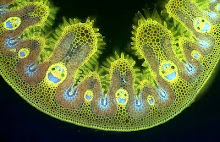In 1825 a French nurseryman called Monsieur Adam grafted a purple-flowered specimen of broom Chamaecytisus purpureus onto a yellow laburnum Laburnum anagyroides stem, hoping to create the broom equivalent of a standard rose. Instead he created a strange graft chimaera - a tree with the tissues of both parents intermingled, that produces three different kinds of flowers. The core of the tree is laburnum, sheathed in layers of broom cells, and the whole arrangement is unstable. In the picture above you can see what appears to be a broom bush sprouting from the branch of the tree, looking like an unusually colourful mistletoe.
This picture, and the one below, show the profusion of purple broom flowers on slender, pliable stems......
... and is probably quite close to what Adam had in mind when he started his experiment, except that he would have hoped to produce this head of flowers on top of a single straight stem.

The whole tree, which looks like a rather lax, poorly growing laburnum in general shape, produces a second form of inflorescence .....

.... that looks like a dangling salmon-pink laburnum blossom - a blend of flower colours of both parents.

Look closely and you can see a hint of laburnum yellow towards the rear of these flowers ....
... but higher up on the tree, amongst the pink blooms, it also produces occasional pure yellow, typical laburnum flowers....

... which you can see here.
This example, of what is a rather rare tree, is currently flowering in Durham University Botanic Garden
To find the marvel of Peru;
And yet these rarities might be allowed
To man, that sovereign thing and proud, Had he not dealt between the bark and tree,
Forbidden mixtures there to see.
No plant now knew the stock from which it came ;
He grafts upon the wild the tame,
That the uncertain and adulterate fruit
Might put the palate in dispute.
Genetic engineering has yet to produce anything in the horticultural world that's as extraordinary as Adam's Laburnum.
In graft hybrids like this the cells of both parents coexist as separate genetic entities in a single organism. You could, at least theoretically, extract cells of each component, put them through sterile tissue culture and recover the two original parents. A similar graft hybrid between hawthorn and medlar, +Crataegomespilus, has also been produced but is rarely found in collections. The + before the Latin name indicates that the plant is a blend of cells from two parents that maintain their independent genetic identity, rather than being the result of sexual hybridisation.
Grafting, which has been most often used in viticulture, fruit tree and rose production was once viewed by many as being a very unnatural practice, comparable with the way many view genetic engineering today. In his poem The Mower, Against Gardens, Andrew Marvell (1621-1678) wrote:
Another world was searched through oceans new,
To find the marvel of Peru;
And yet these rarities might be allowed
To man, that sovereign thing and proud, Had he not dealt between the bark and tree,
Forbidden mixtures there to see.
No plant now knew the stock from which it came ;
He grafts upon the wild the tame,
That the uncertain and adulterate fruit
Might put the palate in dispute.
Genetic engineering has yet to produce anything in the horticultural world that's as extraordinary as Adam's Laburnum.


















